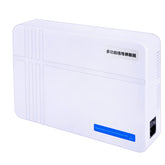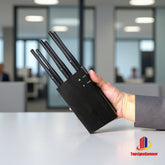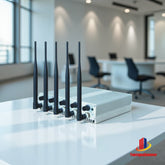Cell Phone Jammers Are Classified By Frequency
4G 2620-2690Mhz
CDMA 850-894MHz
Mobile communication is also called cellular mobile communication. As far as mobile phones in each cell are concerned, they communicate with the base station through the uplink frequency of the channel, and then transfer the signal to MSC to communicate with other mobile phones or fixed phones; The wireless frequencies received by mobile phones are divided according to the frequency bands:
GSM segment 925-960MHz, DCS segment 1805-1880MHz, CDMA segment 869-894MHz, PHS 1900-1990MHz, SCDMA450-470MHz, wCDMA2110-2170MHz, TD-SCDMA2010-2025MHz. Each frequency band is divided into many channels with a certain bandwidth. Each cell uses several channels, one of which is called the broadcast control channel, denoted by BCH, and the other channels are called business channels. In the standby state, the mobile phone intermittently starts the receiving circuit to receive the BCH in the cell. According to the field strength of the BCH signal, the signal strength indicator RSSI is displayed on the LCD with the signal bar. When making an outbound call, first ask the MSC for instructions through the BCH, and the MSC will handle the calling or called, and the MSC will allocate a service channel to the mobile phone according to the channel conditions in the cell, so that the mobile phone can jump from the BCH to the service channel to realize the call. From this point of view, the BCH in the community is the medium and prerequisite for realizing mobile phone communication. If the mobile phone cannot find the BCH in the community, there will be no screen name and signal strength indication on the light screen LCD, that is, the mobile phone will be in the state of no network, no The state of network access, so the mobile phone cannot realize the function of calling or called, that is, the mobile phone signal is equivalent to being blocked.
- 10
- 15
- 20
- 25
- 30
- 50
- Featured
- Best selling
- Alphabetically, A-Z
- Alphabetically, Z-A
- Price, low to high
- Price, high to low
- Date, old to new
- Date, new to old
Sort by:
- Featured
- Best selling
- Alphabetically, A-Z
- Alphabetically, Z-A
- Price, low to high
- Price, high to low
- Date, old to new
- Date, new to old
-
Our products all adopt the patch and high-density integrated circuit resistance, with advanced performance, stable work, ideal is to strengthen information security products, to protect your whereabouts secret and confidential information. The pocket GPS jammer is small jamming device that are extremely portable and...
- $99.69
$179.99- $99.69
- Unit price
- / per
-
6 antenna portable cell phone jammer Adopt brand-new material, in the point, line, face design reached the best state, perfect modelling makes it very popular. With GSM + 3G as the basic interference signal frequency, shielding 4G, GPS and WiFi signal frequency depending on...
- $299.99
$556.99- $299.99
- Unit price
- / per
-
The world first all-in-one powerful WIFI GPS UHF/VHF cell phone signal jammer is designed with 16 antennas which bring us a strong jamming ability. And it can not only cut off all 3G 4G mobile phone signals, but also jam WiFi2.4G 5G CDMA450M GPS...
- $1,166.99
$2,000.00- $1,166.99
- Unit price
- / per
-
The 5 bands portable GPS jammer aiming at car gps tracking,camera spying for those security Units and individuals to protect their privacy. It not only blocker the all GPS signals but also the mobile phone frequency. It can block a variety of signal frequencies,CDMA,...
- $288.99
$400.00- $288.99
- Unit price
- / per
-
Suitable as a mobile phone information security bag, with the function of "mobile phone rest bag". For example, when you place your mobile phone inside the information security bag, it will be in a strictly protected state, while the phone itself will "sleep" and...
- $50.59
$100.00- $50.59
- Unit price
- / per
-
This 8 antenna desktop signal jammer is the only high power 5G jammer on the market.It has a variety of signal interference frequency band combinations, which can interfere with 2G, 3G, 4G, 5G, GSM, wifi, gps, lojack and other signal bands, with a maximum...
- $659.43
$900.00- $659.43
- Unit price
- / per
-
The high power phone signal jammer blocker can block all cell phone frequencies,including GSM,CDMA,DCS,3G,4G.Moreover,you can buy the jamming frequecies WiFi and GPS,or the UHF/VHF frequency jammers. This desktop powerful mobile jammer can be used in the school examination room,court,hospital and office etc.The radius of...
- $448.49
$700.00- $448.49
- Unit price
- / per
-
As the most powerful desktop signal jammer, this device has comprehensive jamming bands, can jamming all mobile phone frequencies, WiFi, GPS, Walkie - talkie and so on. A total of 16 different signal frequencies can be interfered. The range of applications is very wide....
- From $1,078.63
$1,630.59- From $1,078.63
- Unit price
- / per
-
8 antenna desktop non-adjustable high power multiband wifi jammer is made of aluminum alloy with excellent texture, which is a good choice for your home or office use. As you can see, two cooling fans provide thermal protection for the interference device, so as...
- $459.99
$600.00- $459.99
- Unit price
- / per
-
Note: This style is currently old and has been discontinued, and now there are newer styles: better quality and more reliable.New link https://topsignaljammer.com/products/desktop-high-power-gsm-3g-4g-5g-jammer-blocking-wifi-gps-lojack This is the first ever signal jammer with the ability to jam more advanced WIFI frequencies working on 5GHz spectrum. The...
- $560.38
$863.27- $560.38
- Unit price
- / per
-
The high power desktop cell phone jammer with a white aluminum shell,the jammer has a high heat dissipation so that it can work for a long time continuously. it can adjustable jamming radius,jam GSM,3G,4G cellular frequencies. Others signal like GPS,WIF frequencies can be configurable...
- $317.99
$500.00- $317.99
- Unit price
- / per













































